June 30, 2003
Thinking
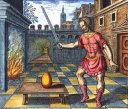 | Take the egg and pierce it with a fiery sword. |
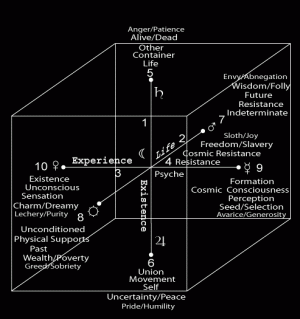
The seven directions in the Cube of Space match Jacques Chevalier's (3-D Mind) planar organization of the brain. Perhaps his next book will add the seventh, interior, direction. If we combine Chevalier with George Lakoff, we are some distance towards a three-dimensional model of the embodied emotional mind. |
"Thinking' developed in response to the challenge presented by the existence of "thoughts." Bion, Seven Servants, p. 85
"The problem is simplified if "thoughts" are regarded as epistemologically prior to thinking and that thinking has to be developed as a method or apparatus for dealing with "thoughts". If this is the case then much will depend on whether the "thoughts" are to be evaded or modified or used as part of an attempt to evade or modify something else. If they are felt to be accretions of stimuli then they may be similar to or identical with beta-elements and as such would lend themselves to treatment by motor discharge and the operation of the musculature to effect the discharge. Talking therefore must be considered as potentially two different activities, one as a mode of communicating thoughts and the other as an employment of the musculature to disencumber the personality of thoughts." Bion, 1962, p.83
| Thoughts exist, therefore I need an I to think them. |
"....thinking is merely a relation of ....drives [desires, passions] to each other...."
NIETZSCHE, 1866, Beyond Good and Evil.
"I never think, and yet when I begin to talk I say the things I have found out in my mind without thinking."
'Federico' in Ernest Hemingway's (1929) A Farewell to Arms.
From Quotations on consciousness from Chris Brand's Personality, Biology and Society: A Resource Manual of Quotations about the Psychology of Individual and Group Differences.
And we add:
"The link between intolerance of frustration and the development of thought is central to an understanding of thought and its disturbances." Bion, Seven Servants, p.29
The hatred of frustration is easily extended to embrace reality itself in a way that is typical of the psychotic; it may then be extended to that part of the mental apparatus on which the awareness of reality and frustration depends. There are degrees of intolerance of frustration, and there are degrees of intensity with which it is denied, until we reach that moderate degree of denial that passes over into the state of mind that, typical of the development of the domination of what Freud called the reality principle, in which frustration and its associated feelings, painful as they are, are tolerated sufficiently to enable the personality to entertain the possibility of modification of frustration rather than denial." Bion, Cogitations, 1992, p.246
"Immaturity, confusion, helplessness and impotence are replaced, in those who are intolerant of frustration, by prematurity, order, omnipotence and power." Bion, Cogitations, 1992, p.299
"'Thinking', in the sense of engaging in that activity which is concerned with the use of thoughts, is embryonic even in the adult and has yet to be developed fully by the race." Bion, Seven Servants, p.85
And:
| Bahir, section 103 The seventh? But, after all, there are only six? This teaches that here is the Temple of the [celestial] Sanctuary, and it bears all [the other six], and that is why it is the seventh. And what is it? The Thought that has neither end nor limit. Similarly this place, too, has neither end nor limit. Gershom Scholem, Origins of the Kabbalah, Princeton, 1990, p.115 |
June 29, 2003
3-D Mind
 | A young bird came into being, flying up from the nest, And fell back into the nest again. |
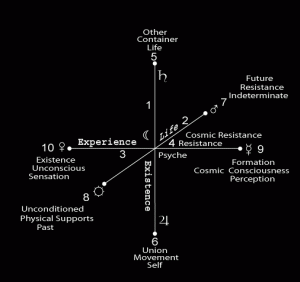
| Neuroscience discovers 3-D organization of brain function.
Up-down organization is concerned with right and wrong, judgment and levels of attention. Left-right organization is concerned with information processing, complementarity and symbolization. Front-back organization is concerned with the expected future and the remembered past. |
"In his three-book exploration of signs and synapse, Jacques Chevalier explores the links between brain science, studies of symbolism, and debates in ancient, modern, and postmodern philosophy to shed light on how brain and signs in language actually interface. In The 3D Mind the author pursues this dialogue across disciplines through an elegantly simple plan that mirrors the three-dimensional structure of the brain, proceeding from the saggital (right-left) to the axial (top-down) and the coronal (front-rear) dimensions of neuropsychology.
Half-Brain Fables and Figs in Paradise starts the trilogy on the lateral plane and explores the tendency of each hemisphere to specialize but also to complement or supplement the other hemisphere. Brain and sign processing is thus shown to involve bimodal weavings or reticles of right-hemispheric similarities and left-hemispheric differences.
The Corpus and the Cortex looks at brain and sign processing from an axial, or vertical, perspective, with an emphasis on neural projections that divide and connect the neocortex and the lower emotional system. It is on this plane that the mind draws lines between right and wrong, pleasure and pain, the practical and the impractical, the lawful and the lawless. The vertical axis also generates variations in levels of attention, ranging from the full awareness of "higher mental faculties" to the inhibitions of hyperpolarization and the autonomic impulses of lower brain and body activity. Signs and synapse are thus constantly wrapped in the foldings of judgments, emotions, and impulses of all kinds.
Scorpions and the Anatomy of Time brings the trilogy onto a third and final plane, the associative fibers that connect the rear lobes to the anterior regions of the brain.
This is the coronal plane that governs the weavings of remembrance and anticipation, recollections of the past and expectations of the future. "
Half-Brain Fables and Figs in Paradise: The 3D Mind, Volume 1
PBS: 3-D Brain Anatomy
3-D Relationships of Structures in the Forebrain
June 27, 2003
Bion: Basic Assumptions & The Grid
 | Sow your gold in the white foliated earth. |
| Bion puts groups into two categories: work groups (getting things done) and basic assumption groups (acting out primitive fantasies and preventing things from getting done).
The three basic assumption groups are fight-flight, corresponding to Klein's paranoid-schizoid postion, dependency, corresponding to Klein's depressive position, and pairing, corresponding to Klein's and Freud's Oedipal fantasy. Basic assumptions are a substitute for thinking and a way to avoid the pain of reality, which would require the understanding of unconscious, psychotic processes (splitting and projective identification) in the individual. |
"Returning to the analyst's intuition of the analysand's experience, similar psychical objects have been experienced by analysand and analyst, having been first communicated by the former to the latter. This is very similar, if not equivalent to, the baby's conveying to the mother by way of normal projective identification its incomprehensible experiences (beta elements).
These beta elements are acted upon by maternal reverie (alpha function), thereby creating (alpha elements) which are returned via maternal (parental) ministrations, often including the spoken, but incomprehensible word - where it is the accompanying music and dance that convey the understanding to the baby of any age.
. . .
The analyst needs, in the unconscious, to be under the auspices as it were, of a mature internal couple - mother and father - in genital communion with one another in relationship to the psychoanalytic objects being experienced."
James A Gooch: Bion's Perspectives on Psychoanalytic Technique
| Bion's Grid | ||||||||
| Defin atory Hypo theses | Psi | Nota tion | Atten tion | Inquiry | Action | ...n, | ||
| A | beta elements | A1 | A2 | A6 | ||||
| B | alpha elements | B1 | B2 | B3 | B4 | B5 | B6 | ...Bn |
| C | Dream Thoughts | C1 | C2 | C3 | C4 | C5 | C6 | ...Cn |
| D | Pre conception | D1 | D2 | D3 | D4 | D5 | D6 | ...Dn |
| E | Conception | E1 | E2 | E3 | E4 | E5 | E6 | ...En |
| F | Concept | F1 | F2 | F3 | F4 | F5 | F6 | ...Fn |
| G | Scientific Deductive System | G2 | ||||||
| H | Algebraic Calculus | |||||||
"... analytic interpretations can be seen to be theories held by the analyst about the models and theories the patient has of the analyst." (Elements of Psycho-analysis, ch. 5, p. 17).
"Beta-elements - This term represents the earliest matrix from which thoughts can be supposed to arise. It partakes of the quality of inanimate object and psychic object without any form of distinction between the two. Thoughts are things, things are thoughts; and they have personality.
Alpha-elements - This term represents the outcome of work done by -function on sense impressions. They are not objects in the world of external reality but are products of work done on the sensa believed to relate to such realities." (Bion, Elements of Psycho-Analysis, ch.6, p.22).
"Calculi - The scientific deductive system may be represented by an algebraic calculus. In the algebraic calculus a number of signs are brought together according to certain rules of combination." (Elements of Psycho-Analysis, ch. 6, p. 24).
Rosa Beatriz Pontes de Miranda Ferreira: The Fundamental Role Of The Grid In Bion's Work
" In the practice of psychoanalysis, the emotional experience can be discerned as a constantly changing pattern of emotional experience. If the psychonanalyst develops his capacity to intuit these experiences, he can become aware of certain experiences which are constantly conjoined. These constant conjunctions become manifest to the psychoanalyst after a period of time (provided he resists an irritable searching after certainty) as a sensuous caleidoscopic change" (Bion,1977a, p.11).
"It is not clear to me whether a negative growth in T(K) in the analyst leads to T(O) or whether there is a caesura between the two transformations. Anyway, I think there is a difference in the analyst's internal attitude when facilitating T(K) and T(O). In T(K), the analyst assumes an internal attitude which facilitates regression towards a sensuous experience. In T(O) he voluntarily tries to keep away from this sensuous experience.
...
The analyst facilitates the process in T(O) although it does not take place in himself alone. T(K) was described as what happened when the mind is touched, now touch and mind are throwed away. The dissolution of the ego of the analyst brings fear of going mad but brings a contact with the magma, the matrix out of which the toughts of the analysand are formed. We can call this a reverie in T(O). It implies a humble attitude, being nothing, dust among the dust. What Goethe means by tender empiricism seems to border on this reverie in T(O): "There is a tender kind of empiricism identifying itself with the object so intimately that in the process it becomes the actual theory." ( cited in Benjamin, 1973, my own translation).
Rudi Vermote: The GRID, that two-dimensional crutch
"The negative grid is meant to represent a mental system for generating lies - in the service of misunderstanding and anti-thought. These lies constitute, in Bion's view, the poison of the mind. It is a notion which remained largely unelaborated in his work - a kind of terra incognita - yet to be laboriously mapped out by clinical exploration. But it is scintillating with possibilities for better understanding the nature of perversity as an aspect of character, as distinct from sexual behaviour or choice. It wholly subverts the current propensity to attach labels of 'perverse' or 'non-perverse' to categories of relationships - e.g., homosexual or heterosexual - and places the distinctions, rather, in the area of psychic reality and meanings as represented by different states of mind.
In conclusion, however, it is the connection between these intrapsychic processes and the social sphere that must be emphasized: the connection, that is, between the basic assumption mentality in the individual, mindless group mentality and the dynamics of the gang. A basic assumption group is particularly rich soil for the implanting of gang propaganda.
. . .
In bridging the two - the individual mind and the public sphere - we have been investigating the negative forces in the personality and the ways in which the internal basic assumption groupings rooted in hatred of the emotions and ultimately of life itself, may find expression in external ways. The 'Fair is foul and foul is fair' mode of inversion and distortion , so brilliantly, elaborated in Macbeth, then crystallizes into the hardcore perversity of the little child's aspiration to 'grow up and live dying' and of the forces of oppression and hatred which spread death and despair across the world. " Waddell & Williams (emphasis and hyperlinks added)
Margot Waddell and Gianna Williams: Reflections on Perverse States of Mind
June 26, 2003
Bion and Thinking

Put a toad to the breasts of a woman, that she may feed it,
And the woman may die, and the toad grows big from the milk.
Rafal T. Prinke - Hunting the Blacke Toade
Adam McLean: Animal Symbolism in the Alchemical Tradition
"For Bion, the 'undigested facts' or beta elements are stored in the form of bodily sensory traces. They are raw elements of sensuous and affective impressions in which psychic and physical are yet indistinguishable. As such they can only be dealt with by projective identification as a form of primitive communication. It has been one of his main contributions to remind us, that much of our lives is lived without thinking outside significant emotional experiences. And that we often busily go about our daily activities without thinking about it's meaning, surrounded by a mass of undigested facts Bion insists: "It is important to distinguish between memories and 'undigested facts'" (1962, p. 7) Because they are not genuine memories, they are unavailable for thought and consciousness until they are transformed by alpha function that is by the interpretation of the selected fact in order to become recycled as genuine memories which can then acquire the possibility of retranscription and be forgotten or recalled. Learning from an emotional experience is indeed a retranscription so that "the mind builds itself, bit by bit, by digesting experiences" (Meltzer, 1984, p. 42) and the Grid will graphically describe the whole progressive process going from corporeity to levels of greater abstraction. But when the 'undigested facts' are not transformed (or metabolized), they remain in the words of Alvin Frank (1969) "The unrememberable and the unforgettable" and in the words of Edelman's the 'remembered present' (p. 120) characteristic of the 'primary order consciousness'." Guy Da Silva
Guy Da Silva: The Emergence of Thinking: Bion as the link between Freud and the Neurosciences
Wilfred Ruprecht Bion. Past and Future
Psychoanalytic Aesthetics: The British School: by Nicola Glover: The Legacy of Wilfred Bion
Michael Rustin: Looking in the Right Place: Complexity Theory, Psychoanalysis and Infant Observation
Robert D. Hinshelwood: How Foulkesian was Bion?
| Freud | Oral | Anal | Oedipal |
| Klein | Paranoid-Schizoid | Depressive | Oedipal |
| Bion | Fight/Flight | Dependency | Pairing |
Laurence J Gould: Correspondences Between Bion's Basic Assumption Theory and Klein's Developmental Positions
David Armstrong: The Work Group Revisited: Reflections on the Practice of Group Relations
David Armstrong: The "Institution in the Mind"
Paramendra Bhagat: W. R. Bion on Group Dynamics
Wilfred Bion 1879 - 1979
W. Gordon Lawrence, Alastair Bain, and Laurence Gould: The fifth basic assumption
"Bion's best known immediate followers, Elliott Jaques and Isabel Menzies Lyth, are also very sober and stoical in their assessments of the barriers to change. Jaques begins his essay on 'Social Systems as a Defence against Persecutory and Depressive Anxiety' (1955) by reiterating that 'social phenomena show a striking correspondence with psychotic processes in individuals', that 'institutions are used by their individual members to reinforce individual mechanisms of defence against anxiety', and 'that the mechanisms of projective and introjective identification operate in linking individual and social behaviour'. He argues the thesis that 'the primary cohesive elements binding individuals into institutionalised human association is that of defence against psychotic anxiety' (Jaques, 1955, pp. 478-9). He points out that the projective and introjective processes he is investigating are basic to even the most complex social processes (p. 481, cf. 481n).
Jaques' conclusion is cautionary and points out the conservative - even reactionary - consequences of our psychotic anxieties and our group and institutional defences against them. He suggests that as a result of these reflections on human nature 'it may become more clear why social change is so difficult to achieve, and why many social problems are so intractable. From the point of view here elaborated, changes in social relationships and procedures call for a restructuring of relationships at the phantasy level, with a consequent demand upon individuals to accept and tolerate changes in their existing patterns of defences against psychotic anxiety. Effective social change is likely to require analysis of the common anxieties and unconscious collusions underlying the social defences determining phantasy social relationships' (p. 498)." Robert M Young: Mental Space and Group Relations
Robert M Young: Mental Space and Group Relations
Selection from Chapter 7 of Mental Space by Robert M. Young
Marc G. Schramm: Basic Assumptions
Kathleen King: Group Dynamics for the Online Professor
Glossary of Group Relations Terms
Robert M Young: Postmodernism and the Subject; Pessimism of the Will
Leigh S. Estabrook: Weaning from the Breast: Facing Unconscious Processes in LIS Education
Lou Raye Nichol: Defense Mechanisms in Teams
Robert Oelsner: Review: Belief and Imagination
Group-Analysis Today: An interview with Diego Napolitani by Maria Luisa Tapparo
Emotion In Organisations: Narcissism V. Social-Ism: W. Gordon Lawrence
Olga Marlin: Group Psychology in the Totalitarian System: A Psychoanalytic View
David P. Levine: Know No Limits: The Destruction of Self-knowledge in Organizations
Myrna Little: Review: Arthur D. Colman. Up from Scapegoating: Awakening Consciousness in Groups
June 25, 2003
Learning from experience
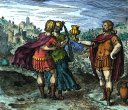
Join brother and sister, and hand them
the cup with the love potion.
The Constellation of Gemini
Ruth El Shaffar: Persiles' Retort: An Alchemical Angle on the Lovers' Labors
Karen-Claire Voss: Spiritual Alchemy: Interpreting Representative Texts and Images
Sparks of the Divinity: Keats' Gnostic Vision of Soul-Making
Bygone Beliefs: Being a Series of Excursions in the Byways of Thought
the Phallic Element in Alchemical Doctrine
"Higher order consciousness depends on building a self through affective intersubjective exchanges. These interactions - with parental figures, with grooming conspecifics, and with sexual partners - are of the same kind as those guiding semiotic exchange and language building. Affectively colored exchanges through symbols initiate semantic bootstrapping. The result is a model of a world rather than of an econiche, along with models of the past, present, and future. At the same time that higher-order consciousness frees us from the tyranny of the remembered present, however, primary consciousness coexists and interacts with the mechanism of higher-order consciousness. Indeed, primary consciousness provides a strong driving force for higher-order processes. We live on several levels at once (Gerald Edelman 1992, p. 150)."
Scott William Gremmels: Wild Analysis: Chaos and Complexity in Therapeutic Practice
Book II: Mapping the Psyche: Psychoanalysis
"Bion is obviously the author who, at least in the psychoanalytic tradition, has placed emotion at the very heart of the matter of mental functioning and the development of the personality. This can be seen in many of his texts from 1962 on, where he comments on the primitive aspect of emotions, and the possibility/necessity that the alpha function should operate on those (aspects of) emotions of which the individual is aware (as well as on his other sense impressions), and that this function (called dream-work-alpha in the first part of his private notes) processes and transforms them symbolically. If this happens, one can learn from experience; if this function is not operating (for different reasons), the emotions (as well as the perceptions) remain unmodified, as beta elements, and have to be somehow evacuated. The road for evacuation (ejection) can be: projective identification, generating responses in the receptor (through realistic projective identification) or hallucinations and/or bizarre objects (through massive or excessive projective identification); psycho-somatic (or somato-psychotic, as Bion also calls them) disturbances or diseases; meaningless (unthought) actions; group behavior of a primitive or basic assumption level; and/or unmentalized, contractual, automatic behavior." Elizabeth T. de Bianchedi
Elizabeth T. de Bianchedi: The Passionate Psychoanalyst or Learning from the Emotional Experience
The more the analyst becomes expert in excluding memory, desire, and understanding from his mental activity, the more he is likely, at least in the early stages, to experience painful emotions that are usually excluded or screened by the conventional apparatus of “memory” of the session, analytical theories, often disguised desires or denials of ignorance, and “understanding” (which consists more often than not of column 2 elements). (p. 48) Bion, W.R. (1981). Notes on memory and desire
Discussion of “The Passionate Psychoanalyst"
Emotion and cognition work together in the brain
PsycheProject: Psychological Models
June 23, 2003
Metaphor

Go to the woman who washes the sheets and do as she does.
Virginia Montecino: Metaphors in Various Disciplines
Conceptual Metaphor Server
Databank: Examples of Usage of Metaphors of Mind
Mind as Physical Space
Leeds: The Metaphor and Metonymy Group
George Lakoff:
"We conceptualize the world using metaphor, so commonly, automatically, and unconsciously that we're not aware of it. As a result, we think metaphorically a large part of the time, and act in our everyday lives on the basis of the metaphors through which we understand the world. Over the past fifteen years, its been discovered that we share a fixed, conventional system of conceptual metaphor--a system of thousands of "metaphorical mappings," each permitting us to understand one domain of experience in terms of another, typically more concrete, domain."
"Our brains are built for metaphorical thought. Since we've evolved with "high-level" cortical areas taking input from "lower level" perceptual and motor areas, it should be no surprise that spatial and motor concepts should form the basis of abstract reason. Metaphor is the name we give to our capacity to use perceptual and motor inferential mechanisms as the basis for abstract inferential mechanisms. Metaphorical language is simply a consequence of this capacity for metaphorical thinking."
George Lakoff Home Page
Piero Scaruffi: George Lakoff: Women, Fire and Dangerous Things
Citeseer: G. Lakoff and M. Johnson, Metaphors We Live By
Tony Veale: CogSci, Metaphor comprehension
Dom Massaro UCSC: Cognitive Psychology Glossary
Cogsci 2001 Programme | The Roles of Body and Mind in Abstract Thought
The Roles of Thought and Experience in the Understanding of Spatio-temporal Metaphors
Cognitive Science Research Papers
Cognitive Science Summaries
Connexions: Current research in cognitive science
Knowledge Ecology Resources
June 22, 2003
Intersubjectivity
where is the subject and where is the object?
projective identification is putting some of your psychic stuff into another person's psychic container for both postive (empathic communication) and negative (defense against (psychotic) anxiety) reasons.
quotes from Robert M Young on Benign and Virulent Identification:
'In projective identification parts of the self and internal objects are split off and projected into the external object, which then becomes possessed by, controlled and identified with the projected parts' (Segal, 1973, p. 27).
'Thus the link between patient and analyst, or infant and breast, is the mechanism of projective identification' (Attacks on Linking, Bion, 1967, p. 106).
'container-contained' ... 'an attempt to raise the concept of projective identification to a general theory of human functioning - of the relations between people, and between groups; of the relationships between internal objects; and of the relationships in the symbolic world between thoughts, ideas, theories, experiences, etc.' (Bion, p. 191).
psychoanalysis always contained the seed of intersubjectivity in the relic of the seduction theory. the history of psychoanalysis is its resistance to reality in the form of intersubjective objects. drive theory->ego psychology->object and part-object relations->projective identification->self and self-object psychology->countertransference and therapetuic framework analysis brings us to an extension of intrapsychic processes into external (interpersonal) reality via the hypothesized mechanism of projective identification, only a hundred years or so after The Interpretations of Dreams.
Jessica Benjamin: Recognition and Destruction: An Outline of Intersubjectivity
Robert Young: Benign and Virulent Identification in Groups and Institutions
Robert M Young: Analytic Space: Countertransference
when everyone is a trauma survivor, and everyone is, no-one is a candidate for (classical) psychoanalysis.
Bloom extends primative unconscious projective identification as a response to trauma to small and large groups, including nations.
"Victims of traumatic experiences also become REENACTORS, but their reenactments are unconscious, not conscious. They follow a script originally written by someone - or something - else, a script that is difficult to amend or edit, largely because it is nonverbal and unknown. Traumatic reenactment has been defined as living in the unremembered past."
Sandra Bloom: Every Time History Repeats Itself the Price Goes Up: The Social Reenactment of Trauma
“Nine A’s of Trauma”: attachment, affect, aggression, authority, awareness, addiction,automaticity, avoidance, alienation.
June 21, 2003
Summer Solstice
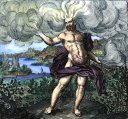
The wind carried him in its belly
Epigram:
When the unborn child, which lies hidden in the womb
of the North wind,
One day will rise to the light, alive,
He alone will be able to surpass all deeds of heroism
With his art, his hand, bodily strength and spirit,
Let him not be born for you like a Coeso, and not as a use abortion,
Not as an Agrippa, but under a lucky star.
Michael Maier's Atalanta Fugiens by H.M.E. De Jong, E.J.Brill, 1969
The Alchemy Website: Atalanta fugiens
Michael Maier: Atalanta fugiens (en francais)
Classical Midi Page: Michael Maier
Atalanta Fugiens (Emblem #21) Commentary by John Eberly
URL fixed: www.psyche.com/blog/ brings you here
there is darkness in the light and light in the darkness:
Eric Weisstein: Summer Solstice
Summer Solstice Celebrations: Ancient & Modern
Summer Solstice: Celtic Myth: Robin and Wren
Greatdreams: The Mystery of Osiris
there is self in the other and other in the self:
Simon Clarke: Projective Identification: From Attack to Empathy?
On "Container and Projective Identification"
P.E. Jongsma-Tieleman: Splitting and projective identification
Robert Young: Ambiguous Space: Projective Identification
Michael Staples: Projective Identification
Projective Identification (good Klein quotes)
what do we see in the mirror?
Mirror Stage
The Mirror Project: Adventures in Refective Surfaces
reflections:
DavidJ.C. MacKay A Short Course in Information Theory
Language is Spatial (PDF)
[CTRL] newphysics & math (Sites)
Roman History: Temple Architecture
Heracles and the Twelve Labours
Azoth Gallery: Alchemical Dialectics
Web Exhibits: Causes of Color
21 century culture and politics
Origami Boulder Company *
Barbies
Kariwanz Fetish Gallery
NITLE Blog Census
Daypop: Top 40 Blog Links
Cyrllic Alphabet in 10 minutes
Kuro5hin: GIF patent dead at 20
burn all gifs: Project of the League for Programming Freedom
Collective Detective: group participation in problem solving
BOFH: The Bastard Operator from Hell Official Archive
Evan Harris: The Next Step in the Spam Control War: Greylisting
LogoTypes (5000+ logos)
Coast to Coast AM Image Gallery: Unexplained, but not Inexplicable
Study: Females get aroused by both sexes
NRO: Deconstructing Rowling: HP really Christian Propaganda
bIPlog: Berkeley Intellectual Property weblog
Bushco:
TNR: Deception and Democracy: The Selling of the Iraq War
Matthew Yglesias: Why the Weapons Matter
Salon: Bush's 9/11 coverup?
Michael Kinsley: Low Opinion: Did Iraq have weapons of mass destruction?
VV: Reason to Deceive: WMD Lies Could Be the New Watergate
June 20, 2003
Today's links
Added to: Psyche's Links
konspire 2b: the power of broadcast
Oliver Willis: Like Kryptonite to Stupid
Kuro5shin: Introduction to the Theory of Relativity Part II
Daniel Reid: The Five Elemental Energies (wu sing)
Introduction to Psychoanalysis
Erik Jackson: sychoanalysis and semiotics
Blackburn: To Feel and Feel Not
Relatively Speaking By Simon Blackburn
From romantic nationalists to thoughtful cosmopolitans
analysis: the origins of values
World Citizenship: A Critique of Martha Nussbaum
Critical Thinking on the Web
butterfliesandwheels: fighting fashionable nonsense
Daniel Dennet: Postmodernism and truth
The Arithmological Structure of Tarot
History of the Pentagram
Masonic Symbolism of the Arithmetical Number Five
78 differences between women and men
Kuro5shin: Dear Senator Hatch (Hatch is a terrorist)
CSM: In volatile Iraq, US curbs press
DC Court of Appeals upholds secret detentions
Why don't we care about the WMD?
WMD Finder
June 19, 2003
June 18, 2003
Picture Test

Humberto R. Maturana:
Symbolic Generalizations or Definitions
Cybernetics Glossary
Category Theory: Eleanor Rosch

June 12, 2003
Cube of Space: Metapsychology

Summary: The meaning of the Cube of Space is lost if it is not understood as a description of our own psychological reality. The space in the Cube of Space is our own psychological space and its dimensions are the psychological dimensions of our own experience. We can easily find its "common-sense" descriptions in our own experience and verify their accuracy or usefullness for ourselves.
The Cube of Space describes the human reality of Adam Qadmon, archetypal man, as composed of an inner life formed in the first four Sephirot (spheres of energy) and the axes and center of the Cube, and an outer life formed by the last six Sephirot and the opposing faces of the Cube. The inner life is timeless and the outer life is experiential and developmental.
Inner space or being is formed by three primary energies, represented by the Hebrew "Mother" letters: Aleph, maximum energy/consciousness, Mem, minimum energy/consciousness, and Sheen, the energy mediating between them. Outer space or being is the reflection ofthose energies as existence, life and experience. Existence is formed by the polarity of self and other, life by the polarity of future and past, and experience by the polarity of feeling and thought, or stimulus and response. The psyche itself, the seventh direction of the Cube, is at the center, though which all the energies pass.


